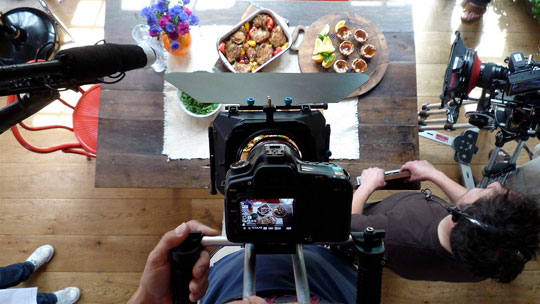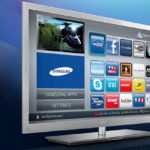
Jamie Oliver’s 30 Minute Meals Lap Up DSLR Dimension
Posted on Nov 19, 2010 by Alex Fice
For Jamie Oliver’s 30 Minute Meals DSLRs meant new views from above
Image Gallery from Jamie Oliver’s 30 Minute Meals
Famous cook and food evangelist Jamie Oliver has always been keen on cameras and even discovered the delights of video on DSLRs before his DoP Paul Gwilliams. Jamie and Paul decided to use the cameras at the first opportunity and that was the recent Channel 4 TV series 30 Minute Meals. Paul explains the process.
Shooting on DSLRs for Jamie Oliver was not a new concept for me. I had been shooting a range of non-broadcast projects for Jamie that included web content, Jamie’s 20 minute meals iPhone app and recently video content for an E-book, but to finally get to use them for broadcast was something I’d been hoping for since the start.
I actually have Jamie to thank for getting me into the whole DSLR thing in the first place – I should explain that Jamie is a big fan of DSLRs for both photography and video – infact on my first DSLR shoot for him, he seemed to know more about the camera than me!
I had been booked for a Digi shoot and at the last minute the Producer phoned me to say Jamie wanted to do it on a DSLR camera – I knew what they were as my photographer wife had one but I had written the video function off as a gimmick for ‘Paps’ and wedding photographers.
So I agreed that the shoot would be an experiment, but needless to say, soon had to eat my words when I realised the kind of images I could extract from one of these cameras.
Shooting on DSLRs over the past year has been a definite learning curve and a process of trial and error. Unlike most broadcast cameras I had been used to which had all of the controls and functions where you wanted them, and all of the ancillary kit in place, I suddenly found myself scouring the Internet on blogs and forums to try and figure out the best kit and work arounds.
The 20 minute meal iPhone app was the first big project. Shot in April 2009 all of the video content for the App would be shot on DSLRs. This was at the time when they only had 30fps mode, but of course this wasn’t a problem for a non-broadcast application. Most of it was shot using two cameras with no viewfinders or monitors, we even had to send the runner for more CF cards when we realised how much space the video was taking up!
Fast forward to June 2010, I bump into Jamie at Fresh One’s studio kitchen and he explained that they are doing a new TV show called 30 Minute Meals. Like Jamie’s other recent TV productions it is to be shot on RED, but he wants to get me on board to see what we can add with some DSLRs. Needless to say I’m made up at the opportunity to finally use the cameras for one of his flagship productions and to see them side by side with the RED.
Shooting 30 Minute Meals
30 Minute meals was shot on three Reds and four DSLRs – three Canon 5Ds and a 7D.
We would shoot four shows per day pretty much as live. The bulk of the show was always going to be shot on RED – there are still two big limitations that negated DSLR use for a whole show – the broadcast limits on the footage from such cameras and the fact that they wanted to shoot almost continuously for 30 minutes meant the 12 minute take limit on the DSLRs didn’t help either.
But the DSLR’s were going to come into their own in other areas.
The look and style of the show would be very much similar to the book of the series shot by Jamie’s favourite food snapper David Loftus. The food and cooking would be shot from every conceivable angle, rich in colour and texture with lots of lovely shallow depth of field – a look that really suits food photography, there would also be a real pace to the show – 30 minutes to cook a three course meal! So lots of angles would be required for the edit to convey that pace.
The Red cameras were set for a floating wide shot of Jamie and a side on close and a front on top shot to capture food. They would remain pretty much set for the 11 days of shooting, with the exception the ‘Pack shots’ shot by Jamie’s long time food shooter Luke Cardiff and a ‘lifestyle’ dining sequence – where the meal would be presented on the table and Jamie and friends would tuck into the finished product while the cameras rolled.
This is one point where Director Martha Delap wanted to get value out of the DSLRs. The idea was to have an overhead shot of the table when the food was presented and whilst it was eaten, and getting a RED overhead would be a time consuming task in the space.
So DSLRs were perfect for the job – light and mobile, I could jump up a ladder and get over the action easily, the 5D was mounted on a shoulder rig and a 70-105 image stabilizer lens fitted the bill for this task.
Another area where Jamie was really keen to use the DSLRs was for an ‘oven cam’. He had commissioned a specially modified oven with a window cut in the side so that we could shoot food as it bubbled and browned in the oven. Bespoke kitchen maker and carpenter Crispin Forster whose studio home we were shooting in had constructed a cupboard in which the camera would be mounted – there would have been no way to fit a RED in there!
The heat build-up inside the cupboard looked to be a major issue due to limited ventilation – the 7D has a sensor overheat warning, but the 5D doesn’t – however they both have something I had never seen before – an internal temp warning and this showed up regularly – the lenses (we used Canon 15mm fisheye and a 28 1.8) were getting even hotter, almost too hot to touch! However despite this punishment apart from the cameras occasionally turning themselves off, I never saw any degradation in the picture.
As well as the oven cam we also tried the cameras as a fridge cam, and a drawer cam again using the 15mm fisheye and using a small LCD monitor via HDMI to set shots. It was great to be able to fit these cameras into a tight space where you would normally end up requiring a minicam – an extra cost , especially for HD.
Whilst each 30 minute show was being shot I would be situated front on between the wide and top shots and follow the action on a close-up. As each show was shot as live, these shots would prove a useful extra angle at a fraction of the cost of another RED.
I shot most of this on the 70-200 L f2.8is. I couldn’t get in too close because of the wide shot, and in fact I even switched to the APS-C body sometimes to get the extra reach because of the crop factor. I actually got to thinking that maybe a 28 –300 might have been good because of finding limitations in zoom range whilst trying to keep up with the action. People bang on about fast lenses and working wide open but I found that I for following the action (Jamie is fast and this was 30 minute meals!) I wanted to stay between about F5.6 – F8 and I still had very shallow depth of field on the close-ups.
Devil In the Details
One area I could go to town with the DoF was the details. I was going to spend some time hoovering up lots of nice little cutaways with a 100mm macro which would drop in all over the show – stuff like various bits of kitchen kit being switched on, food pick-ups, herbs being snipped – all in glorious macro, shallow DOF and again, whizzing around and re-setting wasn’t a problem with this ultra mobile setup.
One thing that never really worked out as monitoring for the director – the REDs with their multi-flavour outputs were hooked up to a gallery some distance away on the next floor, but multi-monitoring on DSLRs is a pain and the HDMI cables don’t work over a long distance. I did trial the Movie Tube set-up with its broadcast VF and video out and I wired up a video sender, but the VF just didn’t seem to work like it does with a broadcast cam, and I ended up wanting my Z Finder or LCD monitor instead.
Sound was thankfully something I didn’t have to worry about on this shoot – the cameras were set to capture ambient sound on their own mics. Synching to the REDs was done by getting a reference shot from a the timecode slate every time I rolled.
Dealing with up to four DSLRs did need organisation though, thankfully my excellent assistant/DIT Daryl Higgins kept on top of the mountain of memory cards and batteries needed to feed these cams – the worrying bit is always when you get to the stage when you have to reformat the cards – have I definitely got that footage?? We did have two cards corrupt on us but Daryl managed to recover the footage with some specialist software.
Because the DSLR and Red footage would be integrated I tried to set the DSLRs to get them as close as possible. Having shot on these cameras for a while and trawled thought the forums the general consensus seems to be to turn everything down in the profiles.
The one problem I do have with that is that when you turn the sharpness down, you are then trying to focus off of a soft looking picture. Having never really encountered moiré issues shooting food I kept the sharpness at a tolerable level.
I’ve subsequently spoken to the guys at Splice who did the post and they seemed to have very little problem matching the RED/5D and I’m really impressed having now seen shows how well the footage from the different cameras matched. In fact having watched the shows closely even I found it difficult to tell which was which!
As ever with DSLRs, 30 Minute Meals was a learning experience! But it was also great to see how DSLR cameras could integrate with a vastly more expensive, purpose built high end broadcast setup and I feel that they proved to be a powerful, cost effective tool to add real aesthetic value in the show.








